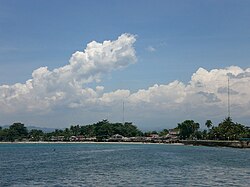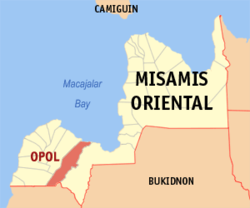Opol
 From Wikipedia - Reading time: 11 min
From Wikipedia - Reading time: 11 min
Opol | |
|---|---|
| Municipality of Opol | |
 Opol Waterfront | |
 Map of Misamis Oriental with Opol highlighted | |
Location within the Philippines | |
| Coordinates: 8°31′N 124°34′E / 8.52°N 124.57°E | |
| Country | Philippines |
| Region | Northern Mindanao |
| Province | Misamis Oriental |
| District | 2nd district |
| Founded | June 15, 1950 |
| Barangays | 14 (see Barangays) |
| Government | |
| • Type | Sangguniang Bayan |
| • mayor of Opol[*] | Jayfrancis D. Bago[1] (PADAYN) |
| • Vice Mayor | Danilo E. Daroy Jr.[2](PADAYN) |
| • Representative | Yevgeny Vincente B. Emano (NP) |
| • Municipal Council | Members |
| • Electorate | 38,811 voters (2022) |
| Area | |
• Total | 175.13 km2 (67.62 sq mi) |
| Elevation | 25 m (82 ft) |
| Highest elevation | 259 m (850 ft) |
| Lowest elevation | −3 m (−10 ft) |
| Population (2020 census)[5] | |
• Total | 66,327 |
| • Density | 380/km2 (980/sq mi) |
| • Households | 16,210 |
| Economy | |
| • Income class | 2nd municipal income class |
| • Poverty incidence | 14.29 |
| • Revenue | ₱ 267.2 million (2020) |
| • Assets | ₱ 631 million (2020) |
| • Expenditure | ₱ 231 million (2020) |
| • Liabilities | ₱ 180.4 million (2020) |
| Service provider | |
| • Electricity | Misamis Oriental 1 Rural Electric Cooperative (MORESCO 1) |
| Time zone | UTC+8 (PST) |
| ZIP code | 9016 |
| PSGC | |
| IDD : area code | +63 (0)88 |
| Native languages | Cebuano Binukid Subanon Tagalog |
| Website | www |
Opol, officially the Municipality of Opol (Cebuano: Lungsod sa Opol; Tagalog: Bayan ng Opol), is a 1st class municipality in the province of Misamis Oriental, Philippines. According to the 2020 census, it has a population of 66,327 people.[5]
Historically, Opol was a more rural area focused on agriculture and fishing, which later attracted migrants from Luzon and Visayas in the area by the turn of 20th century. Over the years, however, the municipality is gradually becoming more urbanized, as a result of local population growth and the expansion of nearby Cagayan de Oro, due to another wave of migrants from Luzon and Visayas in the area. The subdivision of rural land for new residential housing is a matter of some controversy amongst locals. The current Mayor, Jayfrancis D. Bago (commonly known as "Jay Bago"), has held office in Opol after Maximo Seno.
Etymology
[edit]The municipality's name comes from the word "opo" (white gourd), one of the widely cultivated and most abundant crops among Visayans settlers from Bohol who migrated in the area prior to Spanish colonial period. The inhabitants from the nearby village came to the area to buy the famous “opo”, until the place became popularly known as “opo”. Due to the slip of the tongue, most of the inhabitants began referring to the place as “opol”, hence the name.
History
[edit]Although the first inhabitants of Opol were Higaonon people, the area was either once largely uninhabited or slightly populated before Spanish colonial period, until one group of Visayans from Bohol led by a datu, migrated to the place and settled in the area now known as Barangay Bonbon, where they planted different types of crops for their livelihood. This made Higaonons move to the mountains from coastal areas where they initially dwell prior, to avoid contact with Visayans and later from Spaniards. Those who remained then assimilated and intermarried with both Visayans and Spaniards, resulting to the presence of Spanish mestizas and mestizos in the area.
Since the end of Spanish colonial period, Opol started to grow as migrants from Luzon and Visayas as well as the Chinese and Indians flocked to the area seeking new life and various economic opportunities awaited them. Most of the migrants were experienced farmers and other agricultural workers as well as wealthy individuals consisted of Bicolanos, Hiligaynons, Ilocanos, Kapampangans, and Tagalogs in addition to Cebuanos and Boholanos, resulting to the process of Opol's urbanization from being a once largely agricultural area due to its proximity to Cagayan de Oro, where Opol was formerly part of.
Opol was created from the barrios of Opol, Igpit, and Lower Iponan, formerly part of Cagayan de Oro, by virtue of Republic Act No. 524, approved on June 15, 1950.[7]
Geography
[edit]Barangays
[edit]Opol is politically subdivided into 14 barangays. Each barangay consists of puroks while some have sitios.
- Awang
- Bagocboc
- Barra
- Bonbon
- Cauyonan
- Igpit
- Limonda
- Luyong Bonbon
- Malanang
- Nangcaon
- Patag
- Poblacion
- Taboc
- Tingalan
Climate
[edit]| Climate data for Opol, Misamis Oriental | |||||||||||||
|---|---|---|---|---|---|---|---|---|---|---|---|---|---|
| Month | Jan | Feb | Mar | Apr | May | Jun | Jul | Aug | Sep | Oct | Nov | Dec | Year |
| Mean daily maximum °C (°F) | 28 (82) |
29 (84) |
30 (86) |
31 (88) |
30 (86) |
30 (86) |
30 (86) |
30 (86) |
30 (86) |
30 (86) |
29 (84) |
29 (84) |
30 (85) |
| Mean daily minimum °C (°F) | 24 (75) |
24 (75) |
24 (75) |
25 (77) |
26 (79) |
26 (79) |
25 (77) |
25 (77) |
25 (77) |
25 (77) |
25 (77) |
25 (77) |
25 (77) |
| Average precipitation mm (inches) | 271 (10.7) |
217 (8.5) |
193 (7.6) |
178 (7.0) |
344 (13.5) |
423 (16.7) |
362 (14.3) |
358 (14.1) |
329 (13.0) |
320 (12.6) |
322 (12.7) |
260 (10.2) |
3,577 (140.9) |
| Average rainy days | 23.2 | 19.5 | 22.0 | 22.8 | 29.6 | 28.9 | 30.3 | 29.8 | 28.1 | 28.8 | 26.1 | 24.1 | 313.2 |
| Source: Meteoblue[8] | |||||||||||||
Demographics
[edit]
|
| ||||||||||||||||||||||||||||||||||||||||||
| Source: Philippine Statistics Authority[9][10][11][12] | |||||||||||||||||||||||||||||||||||||||||||
In the 2020 census, the population of Opol, Misamis Oriental, was 66,327 people,[5] with a density of 380 inhabitants per square kilometre or 980 inhabitants per square mile.
Visayans form the municipality's majority who descended from earlier migrants from Cebu, Bohol, Siquijor and Negros Oriental long before Spanish colonial period. Higaonons are native inhabitants of Opol despite being a minority living in municipality's inland areas. Other ethnolinguistic groups living in the municipality are Manobos, Iranuns, Maranaos, Maguindanaons and Tausugs as well as other Christian settlers from Ilocandia, Cagayan Valley, Cordillera Administrative Region, Central Luzon, Calabarzon, Mindoro, Marinduque and Bicolandia in Luzon and Panay and Negros Occidental in Visayas. Majority of Opol's population are Roman Catholic Christians.
Cebuano is the most widely spoken language, while Higaonon is also spoken among Opol's indigenous Higaonon tribes. Other languages spoken in the municipality are Bohol dialect of Cebuano, Hiligaynon, Ilocano, Kapampangan, Maguindanaon, Maranao and Tausug. Tagalog/Filipino and English are also widely understood and used in education, business, and administration as the national official languages.
Economy
[edit]Poverty incidence of Opol
10
20
30
40
2006
30.40 2009
31.05 2012
14.27 2015
20.66 2018
12.66 2021
14.29 Source: Philippine Statistics Authority[13][14][15][16][17][18][19][20] |
Key economic activities in Opol include commercial fishing, farming, tourism/hospitality, and light industry. Notable economic infrastructure includes the San Miguel/Coca-Cola bottling plant, Lechem Food Marketing, International Pharmaceuticals, Inc. (IPI), and fishing port at Luyong-Bonbon as well as the municipal market building, located adjacent to the Opol municipal centre.
The Cagayan de Oro - Iligan highway passes through Opol, alongside the coast. The highway is a key inter-regional transport route and comprises an integral part of the Cagayan de Oro - Iligan Corridor Special Development Project. This is a major infrastructure development initiative which is likely to result in significant economic growth for Opol, Misamis Oriental and the adjoining province of Lanao del Norte in coming years
References
[edit]- ^ "Daghang salamat, Opol". Facebook. Jay Bago. 2022-05-20. Retrieved 2022-06-19.
- ^ "THIS HISTORIC WIN IS FOR ALL OF OUR DREAMS — WE MADE IT AND WE WILL CONTINUE TO MAKE IT". Facebook. Vox Daroy. 2022-06-16. Retrieved 2022-06-19.
- ^ Municipality of Opol | (DILG)
- ^ "2015 Census of Population, Report No. 3 – Population, Land Area, and Population Density" (PDF). Philippine Statistics Authority. Quezon City, Philippines. August 2016. ISSN 0117-1453. Archived (PDF) from the original on May 25, 2021. Retrieved July 16, 2021.
- ^ a b c Census of Population (2020). "Region X (Northern Mindanao)". Total Population by Province, City, Municipality and Barangay. Philippine Statistics Authority. Retrieved 8 July 2021.
- ^ "PSA Releases the 2021 City and Municipal Level Poverty Estimates". Philippine Statistics Authority. 2 April 2024. Retrieved 28 April 2024.
- ^ "An act creating the municipality of Opol, province of Misamis Oriental". LawPH.com. Retrieved 2011-04-09.
- ^ "Opol: Average Temperatures and Rainfall". Meteoblue. Retrieved 29 April 2020.
- ^ Census of Population (2015). "Region X (Northern Mindanao)". Total Population by Province, City, Municipality and Barangay. Philippine Statistics Authority. Retrieved 20 June 2016.
- ^ Census of Population and Housing (2010). "Region X (Northern Mindanao)" (PDF). Total Population by Province, City, Municipality and Barangay. National Statistics Office. Retrieved 29 June 2016.
- ^ Censuses of Population (1903–2007). "Region X (Northern Mindanao)". Table 1. Population Enumerated in Various Censuses by Province/Highly Urbanized City: 1903 to 2007. National Statistics Office.
- ^ "Province of Misamis Oriental". Municipality Population Data. Local Water Utilities Administration Research Division. Retrieved 17 December 2016.
- ^ "Poverty incidence (PI):". Philippine Statistics Authority. Retrieved December 28, 2020.
- ^ "Estimation of Local Poverty in the Philippines" (PDF). Philippine Statistics Authority. 29 November 2005.
- ^ "2003 City and Municipal Level Poverty Estimates" (PDF). Philippine Statistics Authority. 23 March 2009.
- ^ "City and Municipal Level Poverty Estimates; 2006 and 2009" (PDF). Philippine Statistics Authority. 3 August 2012.
- ^ "2012 Municipal and City Level Poverty Estimates" (PDF). Philippine Statistics Authority. 31 May 2016.
- ^ "Municipal and City Level Small Area Poverty Estimates; 2009, 2012 and 2015". Philippine Statistics Authority. 10 July 2019.
- ^ "PSA Releases the 2018 Municipal and City Level Poverty Estimates". Philippine Statistics Authority. 15 December 2021. Retrieved 22 January 2022.
- ^ "PSA Releases the 2021 City and Municipal Level Poverty Estimates". Philippine Statistics Authority. 2 April 2024. Retrieved 28 April 2024.
 KSF
KSF

